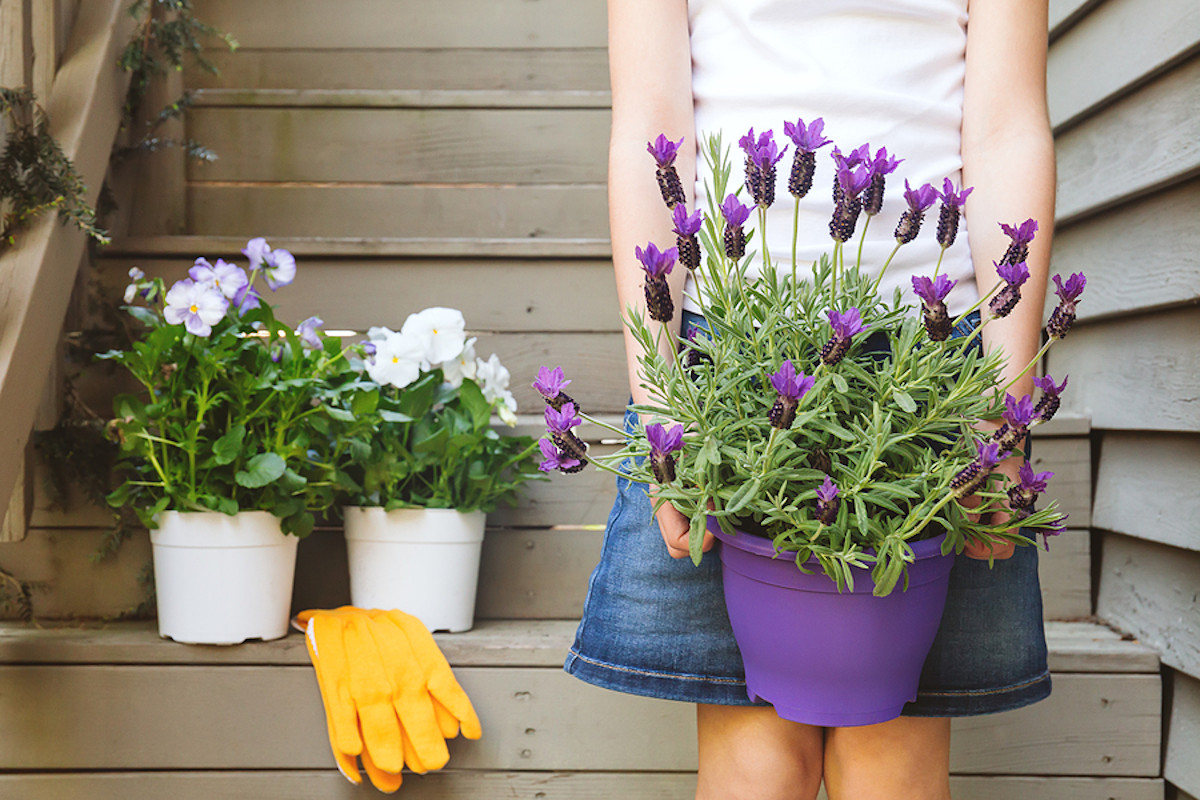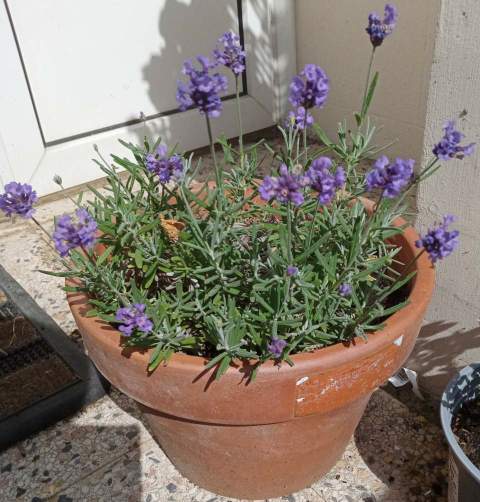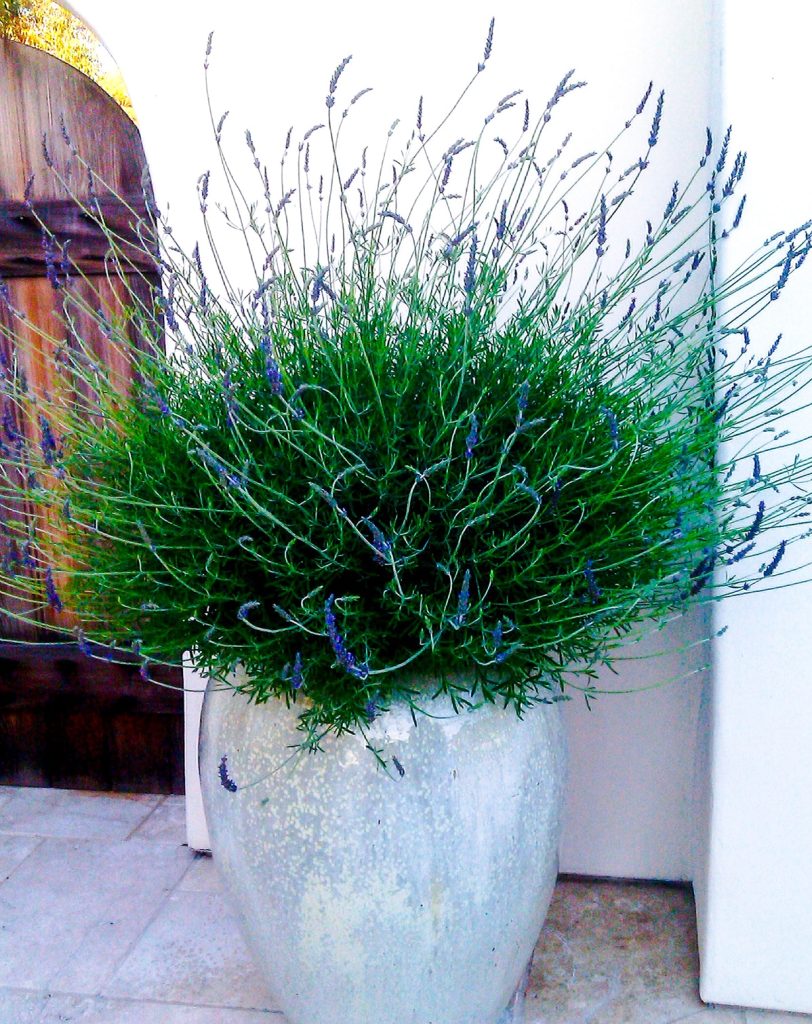
Since the roots of lavender plants grown in pots are more exposed to the cold in winter and the hot, dry weather in summer than if they were planted in the ground, English lavenders are well suited to growing in pots because they are both cold hardy and drought tolerant (more so than other lavender species).
Additionally, pots and containers improve air flow and drainage, recreating the ideal growing conditions for lavender. Unlike other types of lavender that require winter protection, English lavender is cold hardy (up to zone 4) and can endure frosts, so you may leave the pot outside all winter.
Continue reading to learn more about English lavenders (Lavandula angustifolia), the finest soil mix for potted plants, how to water, prune, and take care of them.
Table of Contents
Why English Lavenders are the Best Lavenders for Pots

The fact that English lavender is by far the most cold hardy of all the lavenders, however, makes it more ideal for pots than other lavender species.
This is crucial because, despite the many benefits of growing lavender in pots, the plant will be more susceptible to cooler temperatures because its root system will be above ground rather than more protected as it would be in garden soil.
French and Spanish types of lavender require a warmer temperature with winter lows above freezing because they are not cold tolerant.
The English lavender species, on the other hand, can withstand cold winters and is hardy up to USDA zone 4. It can withstand frosts and snow and will recover the following year without being harmed by the additional exposure of its root systems from being above ground in pots.
While lavender plants in pots may be exposed to milder temperatures, they are also more vulnerable to drying out quickly since the intense sunlight that lavender plants prefer can heat the actual pot and speed up soil evaporation.
Due to the Mediterranean ancestry of English lavender, this adaptable plant is able to withstand both extremes that can occur with pots. However, additional caution should be used when watering lavenders in pots (read more about this below).
English lavenders also have lovely blossoms and a fantastic aroma, which is why they are commercially farmed.
Hidcote, Munstead, Pink Purfume, Alba, and Jean Davis are a few popular English lavender kinds, though it should be emphasized that all English lavenders are appropriate for growing in pots.
How to Grow English lavenders in pots

When it comes to the sort of pot they are in, English lavenders are not very picky. However, it is crucial that the pot has drainage holes at the bottom since without them, water will collect there and cause root rot.
It is always a good idea to cover the drainage holes with 1 inch of gravel or “crocs” to prevent them from becoming clogged by compacted soil or other materials because proper drainage is particularly crucial for English lavenders.
The size of the container and the mature size of the lavender can be compared in terms of size. However, even if the lavender is a smaller kind, I would plant it in a pot no smaller than 12 to 16 inches wide in hot areas because tiny pots can dry out rapidly and also provide less insulation for the root system in the cold, making a bigger container more resilient to extreme weather.
Remember that you can simply repot lavender if it gets too big for the pot (this is best done in the spring), but I would recommend reading my guide on transplanting lavenders first to reduce any transplant shock.
Soil Mix for Potted English Lavenders
English lavender grows most effectively and produces the most flowers on low to medium fertility, highly well-draining soil.
It is always best practice to modify the compost with sand or gravel before planting because lavender’s roots do not like to be in thick compost that retains too much water.
With roughly 30% coarse sand or gravel to 70% garden or multipurpose store-bought compost, English lavenders thrive quite well.
The ideal porous structure for water to drain through the pot and out the bottom is provided by the sand and gravel. Additionally, these materials will balance out the compost’s fertility (remember lavenders need to be in lower fertility soils in order to flower).
It may seem strange that a plant would prefer a fast-draining, low-fertility soil mix, yet this is the environment in which lavender grows in its native Mediterranean region. (Despite the term “English,” all lavenders are actually Southern European in origin.)
The right combination of nutrients will be provided by compost and minerals (sand or gravel) for lavenders to produce magnificent oil, aroma, and blossoms. English lavenders don’t require feeding because doing so will encourage the growth of foliage at the expense of blooms, making your lavender leggy and irregular-shaped.
Watering English Lavenders in Pots
English Lavenders are drought hardy plants. In general, lavenders are much more tolerant of inadequate watering than over watering, which frequently causes root rot.
Beware! An English lavender plant that has been overwatered can frequently have a drooping aspect and foliage that has turned brown or yellow, giving the image of being underwatered. (If you experience this issue, read my post on how to fix drooping lavender.)
| watering English lavender plants in pots | When should I water? |
| Long-standing English Lavender | Every two weeks, give Lavender a good soak. You can wait a few days before watering if there has been rain and the soil is still wet. Instead, wait until the soil has dried. If there has been a prolonged period of hot, sunny weather, you might need to water once every ten days. |
| fresh plants | Water your plants every three days for the first ten days after planting, then cut back to once per week for the first three months. For the first year, drink water once every 10 to 14 days. |
| In the Winter | Lavenders are in a dormant state over the winter and will receive enough moisture from the environment if left outside (English Lavenders can tolerate cold weather). In order to prevent them from entirely drying out throughout the winter if they are brought inside, they will need watering once every 4-6 weeks. |
How Much Water to Use
English lavenders benefit from the soak and dry method of irrigation, which involves giving them a generous drink once every two weeks and letting the soil become dry in between.
Give the plant plenty of water until only a trickle of water is coming out the bottom of the pot. This will stimulate the roots to develop deeply and firmly, which will boost the plant’s resistance to drought.
English lavenders grown in pots need to have good soil drainage, which may be seen by a trickle of water coming out the bottom of the pot.
Be firm with your once per week watering regimen because problems associated with overwatering lavender are not caused by the amount of water used, but rather by the frequency of watering.
The exact amount of water does not important as long as you have supplemented the soil with sand or gravel and as long as the soil receives a good soak.
Read my article for further information on when to water lavender as it describes in great detail how frequently you should water lavender in various situations.
Sunlight
All lavender species fare best in full sun and will not grow very well, if at all in the shade. A lavender plant will bloom fewer the less sunlight it gets.
During the growing season, make sure to arrange your potted lavender in a location that receives at least 6 hours of sun (ideally morning sun) daily.
By doing this, you can be sure that your lavender plant will stay strong, blossom, and generate more oil, which is ultimately what gives it its distinctive perfume.
Pruning Potted English Lavender to ensure Winter Survival
With the proper care, English lavenders can survive up to 15 years. Pruning lavender at least once or twice a year is one of the most crucial best practices for extending the life of English lavenders (or any lavender species).
Pruning will aid in preventing lanky growth, encourage flower production, and preserve a good compact form that successfully resists winter weather and prevents woody growth from the base.
The lavender should be pruned for the first time in the early spring when the first green leaves start to emerge from the lavender’s base.
Trim the lavender’s top third of green growth to create a lovely rounded mound shape. It is crucial to only cut into the more recent, flexible growth rather than the rigid, woody base because the latter has a propensity to split off and not regenerate, leaving you with lavender that is malformed.
Read my article to see what you can do if you are experiencing issues with woody lavender.
A good set of sterile pruners or shears will work for this.
For a detailed visual explanation on how to prune lavender in the spring, I suggest watching this video:
The second pruning is much lighter and consists of only trimming the flower stalks to keep the plant’s rounded shape. I like to save the trimmings to make pretty handmade potpourri!
The lavender’s spherical shape will assist it deflect snow and stop ice from quickly penetrating the shrub’s woody root.
This is crucial to conduct for English lavender because only the English species and a few hybrids are lavender varieties that can withstand cold winter temperatures and continue to bloom year after year.
There are a few recommended practices that lavender growers should adhere to to guarantee that lavenders survive and blossom successfully the following spring, which is why I produced an essay on how to prepare lavenders for winter.
Key Takeaways:
- The best lavenders for growing in pots are English lavenders since their roots are less well-insulated in containers and they can withstand a wider variety of temperatures and environmental conditions.
- Additionally, pots offer good drainage and airflow, and you may readily modify the soil to suit English lavender’s requirements.
- Because lavender cannot tolerate soggy soil, the pot’s bottom must have drainage holes.
- During the growing season, established potted lavender plants require watering every two weeks. English lavenders left outside will get enough hydration from the weather since they will be in a state of dormancy. Newly planted lavender needs to be watered more frequently for the first year.
- Since English lavenders are cold hardy, they typically do not require winter protection in temperate climates. However, it is crucial to regularly prune them to keep them from turning woody, promote blooms, and guarantee the lavender keeps a nice, rounded shape that effectively withstands winter weather.
FAQ
Does lavender grow better in pots or ground?
Full light and proper drainage are essential for lavender. In the winter, it is more likely to die from too much moisture than from the cold. Although the plant will be more susceptible to cold temperatures than it would be in the ground, a container is a great way to promote drainage.
Which lavender is easiest to grow?
The simplest lavenders to cultivate are English types like “Munstead” and “Hidcote,” which require little care and can thrive in both hot and cold areas. English lavenders are the easiest lavenders to grow.
When should I plant lavender in pots?
April
Does lavender survive in pots?
Lavender grows quite well in containers. It really grows better in pots in the Deep South because of the enhanced drainage and airflow. Although the plants flourish in the dry conditions of the West, they are typically regarded as annuals in the South.
